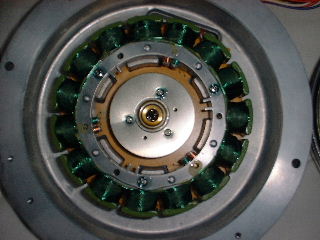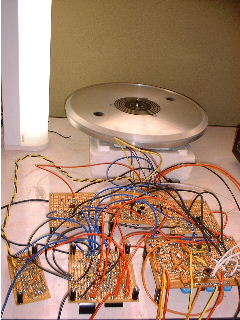| HOME |
| DirectDrive - The Hows And Whys |
| DirectDrive - Owning a DD |
| DirectDrive - Museum |
| DirectDrive - Tech-Talk |
| DirectDrive - Tonearms |

Now here it gets technical. For all those around who really want to know how these machines
work I try to explain it. I take the Technics SP-10Mk2 as an example as I know this machine quite
good and because its motor-regulation is more or less represantative for most decks made in the late 70s.
For those who want a look inside there are pictures of the motor and bearing of a Mk2.
I have also provided some circuit diagrams of the electronics as you'll see more or less common 70s stuff...
A PLL-Quartz Motor-Regulation As Used By The Technics SP-10 Mk2
This is such a good and classical motor-control that it deserves to be covered in depth a little
A DC-generator integrated in the motor itself delivers a signal with a frequency proportional to
the actual platter-speed. This signal then is converted with a frequency-to-voltage converter to
deliver a speed-proportional current. This is then fed into the motor-controller to rgulate the motor.
This loop alone assures quite a constant speed of the motor.
At the same time the signal of the DC-generator described above is fed into another stage where its
phase is compared with a signal that is won by a programmable frequency divider which is fed by a highly
contant reference-signal from a quarz-oscillator.
The reference-signal is quarz-constant too. The slightest differences in phase between both signals
will then be compensated and fed to the motor along with the output of the speed-control stage described
above.
That way only a very small and practically constant phase-difference between the position of the platter
and the reference-signal is not compensated by this phase-locked-loop. Constant phase.difference by the
way means that platter-speed is exactly equal to the quarz-generated reference signal.
That said you see that platter-speed almost entirely dependeds from the reference-signal itself. To keep this as constant as possible a quarz-oscillator is used which is completely independent of mains-current, mains-frequency or temperature-changes. The output of this oscillator is fed to a frequency-divider which divides this frequency down according to the speed of the platter. So the reference-signal has almost constant frequency.
This frequency-divider is "programmable" - the factor of the divider can be changed by digital informations fed into its programmable sockets. Three digital informations representing 33,3, 45, 78 rpm are stored in a rom. They are selected by the speed-selector switch and then fed to the frequency-divider circuit. Thanks of these advanced control-circuits the player keeps platter-speed almost constant.
The SP-10Mk2 also features a strobe. The strobe of the SP10Mk2 is not fed by the mains as usual but by
the 'quarz-constant' reference current. Another divider changes the signal in a way that together with
the 190 strobe-stripes underneath the platter the strobe always seems to stand still. The advantage
is that you need only one strobe-ring for all speeds and the user can't mix them up. Dirty mains
which usually disturb the strobe are neglectable, too.
With a system like the SP10Mk2 platter-speed is far more constant than the mains current.
If you see the strobe of an SP10Mk2 move than there IS something wrong with the regulation-circuit.
The SP10s regulation-circuits consisted of 108 transistors, 14 IC's, and 32 diodes and condensators.
These are located on six circuit-boards with four of them under the platter and two of them in the
separate housing of the power-supply.
Take a look at the motor and the main-bearing of an SP10Mk2:

Sooo many cables:
